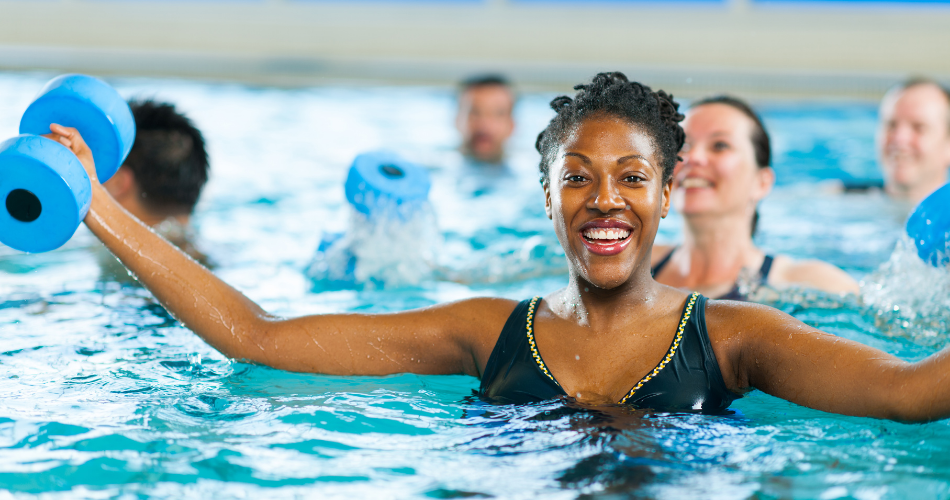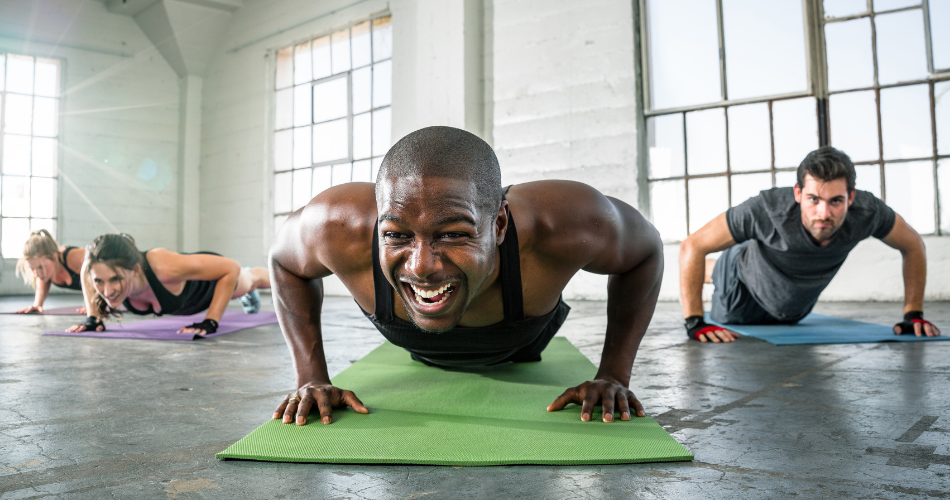Share this page
blog
From Aquafit to Zumba - our fitness class round-up
How can you know which one is best for you if you’re not even sure what they are?
So, you’ve found a new fitness centre, bought the workout clothes you’ve been dreaming of, and you’re ready to sign up for some classes. Aaaaand then you check the schedule and realise there are way more options here than you thought there would be. Some of them are straightforward enough - yoga, pilates, boxercise - but the rest are a complete mystery.
How can you know which one is best for you if you’re not even sure what they are? Not to worry! If you’re unsure of where to start with exercise classes, we’ve got a quick and handy guide to pretty much all the classes you can find on a gym timetable. You’ll find something you love in no time.

Aqua fitness
As you can probably figure out, all aqua fitness workouts take place in a pool. Aqua fitness classes, also known by aqua aerobics, are fun, sociable, and best of all, super accessible. Regardless of age, ability, or fitness level, almost anyone can join in and improve their health, due to aquafit’s low-impact nature. You don’t even have to be able to swim, as most of the action takes place standing up.
Barre
Barre classes are similar to yoga and pilates classes, though are distinct in their use of a ballet barre and movements inspired by ballet. The exercises used in barre workouts are low-intensity and repetitive, and focus on building up strength in the lower body and core. A solid choice if you dreamed of being a ballet dancer when you were little!
Boxercise
This one pretty much does what it says on the tin, boxercise workouts include exercises based on the training regimes of professional boxers. However, while participants will find themselves throwing lots of punches at specialised pads, no part of your boxercise class will involve actual combat with an opponent. This makes it the perfect way to reap all the health benefits boxing has to offer without ever stepping into a ring.
Circuits
Circuit fitness classes typically involve moving around a room and ‘visiting’ different stations. At each station you’ll perform a certain exercise for as long as you can within a set time. These exercises may make use of equipment like skipping ropes and weights, or you may only perform body weight exercises.

HIIT
Similar to circuits, HIIT classes consist of performing set exercises for a certain amount of time, with rests in between each exercise. HIIT stands for High Intensity Interval Training, so expect these exercises to be demanding, and, well, high-intensity! Unlike circuits, these exercises are generally performed together with the rest of the class. HIIT workouts are a great option if you like to exercise in short, high-energy bursts.
Iyengar Yoga
In Iyengar yoga, poses are held for a relatively long time, allowing the body to relax and settle into each position. Iyengar can also be distinguished by its focus on precision, and its use of props such as specialised belts and blocks. Iyengar yoga is one of the most popular forms practised today, and most yoga classes will either teach this, or vinyasa-style yoga (see below).
Kettlebells
If you’re looking for a simple way to fit strength training for your whole body in one class, look no further than a kettlebell class. Kettlebells are specially designed weights with attached handles, and can be used in a variety of exercises, usually involving swinging, lifting, and squatting. If you’d like to start dabbling in the world of weightlifting, kettlebell classes are a good first step to learning proper posture and correct lifting techniques.
Pilates
Named after its creator, German fitness specialist Joseph Pilates, Pilates is an exercise system based on performing precise, controlled movements. The aim of Pilates is to increase flexibility, stamina, and strength, particularly within the core, which is the central focus of the practise. Exercises are typically performed on a mat, with little equipment, making Pilates classes a good choice for pretty much anyone, regardless of ability.
Pole
Looking for something different to try in the New Year? How about pole dancing? No, really. Pole fitness, or just ‘pole’, classes are popping up everywhere, and fast. And while it may sound bizarre, hoisting yourself up onto a pole and pulling off some tricky techniques (often upside down) burns fat and builds muscle faster than you’d think. Plus, the moves are much easier than they look, and you get to look incredible while doing them!

Power Yoga
Okay, so we know what yoga is, but what on Earth is power yoga? Power yoga, much like vinyasa-style yoga, is used to improve flexibility, balance, and stamina. What makes a power yoga workout different is that it is far more intense, and emphasises exercise rather than relaxation. If you’re heading into a power yoga class, you can expect to be working up a sweat, rather than a chilled-out stretching session.
Spin
‘Spin’ is a broad term, and spin classes can vary widely in terms of structure and intensity, but if you see the word spin, stationary bikes will be involved. Some classes even make use of screens and digital displays to simulate terrain and make the experience all the more immersive and entertaining. And the best part: the bikes’ adjustable intensity makes it possible for anyone of any fitness level to participate.
Vinyasa Flow
Also called Ashtanga Vinyasa Yoga, this form of yoga consists of sequences of yoga poses (asanas) set to a pattern of breathing. The emphasis placed on controlled breathing results in a steady ‘flow’ of movements (vinyasas) from one position to another. Most yoga classes will either teach this style of yoga, or Iyengar-style yoga (see above).
Zumba
Insanely fun, and instantly addictive, Zumba classes somehow find a way to make cardio entertaining, which is saying something. Zumba dance is characterised by its use of Latin music, its choreographed dance routines, and its inclusivity. The range of classes available means anyone from 0 to 100 can participate, but there are also high-intensity classes available for those of us who enjoy pushing ourselves that little bit harder.
Hopefully this short guide has helped clear things up a little, so you can turn up to your classes knowing exactly what to expect.
Looking for more information on keeping your body happy and healthy? We've got lots of great articles you can check out. Plus you can subscribe to our newsletter for articles in your inbox plus special offers, details on our upcoming events and the LiveFit Festival!
VIEW MORE ARTICLES
others you may be interested in
A Guide to Running with Rachel Grunwell
Personal trainer Rachel Grunwell, who coaches runners, and is also a yoga teacher who specialises in working with athletes, talks about getting started with running and how to stay motivated.
A Beginner's Guide to Squash with John Fletcher
Squash Auckland’s General Manager, A-Grade Player, and Lifelong Squash Enthusiast John Fletcher explains why you should be playing the world’s healthiest sport and how to get started.
11 Workout Tips for Beginners
How often should I do it? What kind of exercise should I do? If you have these questions then these 11 workout tips for beginners might be worth the read!
